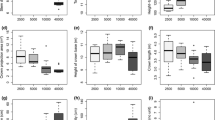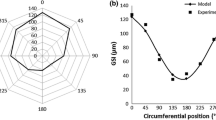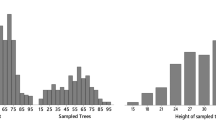Abstract
Aims
In European Beech (Fagus sylvatica L.) large growth stresses lead to severe log end splitting that devaluate beech timber. Our study aimed at detecting relationships between growth stress and some morphology parameters in trees.
Methods
Growth stress indicators were recorded for 440 mature trees in nine stands from five European countries, together with morphology parameters.
Results
Most trees displayed an uneven distribution of growth stress around the trunk. Moreover, growth stress intensity varied largely between individual trees. Geometry of the trunk was a poor predictor of growth stress intensity. Crown asymmetry resulted in a larger stress dissymmetry within trees. Trunk inclination was not correlated to max tension stress, contrary to what is usually found in younger trees. In the case of small inclination, growth stress was close to expected from biomechanics of restoring verticality. Trees exhibiting a larger inclination probably evolved a different mechanical solution: a rather large crown, lower tree slenderness and a sufficient asymmetry in growth stress as to prevent a higher inclination due to growth.
Conclusion
A large slenderness is the best accurate predictor of a large growth stress, although variations in the ratio height/diameter at breast height explained only 10 % of the variability of growth stress. A large crown surface was the best predictor of a low level of growth stress. A large spacing between trees seems a good solution to lower the risk of growth stress in mature beech.








Similar content being viewed by others
References
Alméras T, Fournier M (2009) Biomechanical design and long-term stability of trees: morphological and wood traits involved in the balance between weight increase and the gravitropic reaction. J Theor Biol 256:370–381. doi: http://dx.doi.org/10.1016/j.jtbi.2008.10.011
Alméras T, Thibaut A, Gril J (2005) Effect of circumferential heterogeneity of wood maturation strain, modulus of elasticity and radial growth on the regulation of stem orientation in trees. Trees 19:457–467. doi:10.1007/s00468-005-0407-6
Alvarez-Gonzalez JG, Zingg A, Gadow KV (2010) Estimating growth in beech forests: a study based on long term experiments in Switzerland. Ann For Sci 67:307. doi: http://dx.doi.org/10.1051/forest/2009113
Archer RR (1986) Growth stresses and strains in trees. Springer, Berlin, pp 1–249
Baillères H (1994) Précontraintes de Croissance et Propriétés Mécanophysiques de Clones d’Eucalyptus (Pointe Noire–Congo): Hétérogénéités, Corrélations et Interprétations Histologiques. Thèse Université Bordeaux I, 162 p
Barbacci A, Constant T, Magnenet V, Nepveu G, Fournier M (2009) Experimental analysis of the formation of tension wood induced by gravity for three mature beech trees on a 25 years duration. In 6th Plant Biomechanics Conference. pp. 306–314
Becker G, Beimgraben T (2001) Occurrence and relevance of growth stresses in Beech (Fagus sylvatica L.) in Central Europe, Final Report of FAIR-project CT 98–3606, Coordinator Prof. G. Becker, Institut für Forstbenutzung und forstliche Arbeitwissenschaft, Albert-Ludwigs Universität, Freiburg, Germany, 323 p
Coutand C, Fournier M, Moulia B (2007) The gravitropic response of poplar trunks: key roles of prestressed wood regulation and the relative kinetics of cambial growth versus wood maturation. Plant Physiol 144:1166–1180. doi: http://dx.doi.org/10.1104/pp.106.088153
Ferrand JC (1982) Etude des contraintes de croissance. Deuxième partie: variabilité en forêt des contraintes de croissance du hêtre (Fagus sylvatica L.). Ann Sci For 39:187–218
Fournier M, Chanson B, Thibaut B, Guitard D (1991) Mécanique de l’arbre sur pied: modélisation d’une structure en croissance soumise à des chargements permanents, évolutifs. Partie 2: application à l’analyse tridimensionnelle des contraintes de maturation. Ann Sci For 48:527–546
Fournier M, Baillères H, Chanson B (1994a) Tree biomechanics: growth, cumulative prestresses and re-orientations. Biomimetics 2:229–251
Fournier M, Chanson B, Thibaut B, Guitard D (1994b) Mesure des déformations résiduelles de croissance à la surface des arbres, en relation avec leur morphologie. Observations sur différentes espèces. Ann Sci For 51: 249–266. doi: http://dx.doi.org/10.1051/forest:19940305
Jourez B, Avella-Shaw T (2003) Effect of gravitational stimulus duration on tension wood formation in young stems of poplar (Populus euramericana cv ‘Ghoy’). Ann Sci For 60:31–41. doi: http://dx.doi.org/10.1051/forest:2002071
Jullien D, Gril J (1996) Mesure des déformations bloquées dans un disque de bois vert. Méthode de la fermeture. Ann Sci For 53:955–966. doi: http://dx.doi.org/10.1051/forest:19960504
Jullien D, Gril J (2008) Growth strain assessment at the periphery of small-diameter trees using the two-grooves method: influence of operating parameters estimated by numerical simulations. Wood Sci Technol 42:551–565. doi:10.1007/s00226-008-0202-9
Knoke T, Stang S, Remler N, Seifert T (2006) Ranking the importance of quality variables for the price of high quality beech timber (Fagus sylvatica L.). Ann For Sci 63: 399–413. doi: http://dx.doi.org/10.1051/forest:2006020
Kubler H (1987) Growth stresses in trees and related wood properties. For Abstr 48:131–189
Liu S, Loup C, Gril J, Dumonceaud O, Thibaut A, and Thibaut B (2005) Studies on European beech (Fagus sylvatica L.). Part 1: variations of wood color parameters. Ann For Sci 62:625–632. doi: http://dx.doi.org/10.1051/forest:2005063
Moulia B, Fournier M (2009) The power and control of gravitropic movements in plants: a biomechanical and systems biology view. J Exp Bot 60:461–486. doi:10.1093/jxb/ern341
Polge H (1981) Influence des éclaircies sur les contraintes de croissance du hêtre. Ann Sci For 38:407–423
Saurat J, Gueneau P (1976) Growth stresses in beech. Wood Sci Technol 10:111–123. doi:10.1007/BF00416786
Thibaut B, Gril J (2003) Growth stresses. Chapter 6: 137–156. In Barnett JR and Jeronimidis G (eds) Wood quality and its biological basis. Boca Raton, FL, CRC Press
Wilson BF, Archer RR (1979) Tree design: some biological solutions to mechanical problems. Bioscience 29:293–298
Wilson BF, Gartner BL (1996) Lean in red alder (Alnus rubra): growth stress, tension wood, and righting response. Can J For Res 26:1951–1956. doi:10.1139/x26-220
Yang JL, Baillères H, Okuyama T, Muneri A, Downes G (2005) Measurement methods for longitudinal surface strain in trees: a review. Aust For 68:34–43
Acknowledgements
The authors would like to thank all the people that have been involved in the huge campaign of data measurements and all the people that have collaborated to this large European project. They also would like to thank their colleague Tancrède Alméras who has helped a lot to conduct statistical data analyses of this paper.
Funding
This work was performed in the frame of the contract FAIR-98-3606 “Stresses in beech” supported by the European Commission (Becker and Beimgraben 2001).
Author information
Authors and Affiliations
Corresponding author
Additional information
Handling Editor: Jean-Michel Leban
Contribution of the co-authors
The last author is at the origin of the research project; he has coordinated it. The four authors have participated to run the experiments. The three last authors were much involved in data analyses and in the writing of the final report of the project. The first author has coordinated the data analyses and the writing of the paper.
Rights and permissions
About this article
Cite this article
Jullien, D., Widmann, R., Loup, C. et al. Relationship between tree morphology and growth stress in mature European beech stands. Annals of Forest Science 70, 133–142 (2013). https://doi.org/10.1007/s13595-012-0247-7
Received:
Accepted:
Published:
Issue Date:
DOI: https://doi.org/10.1007/s13595-012-0247-7




